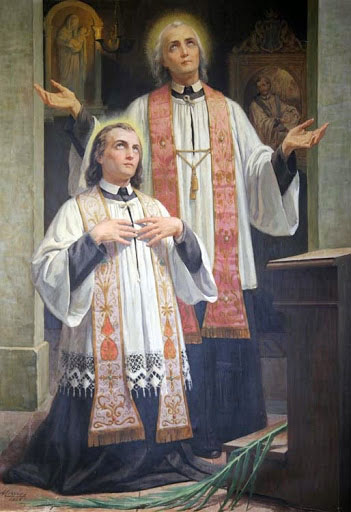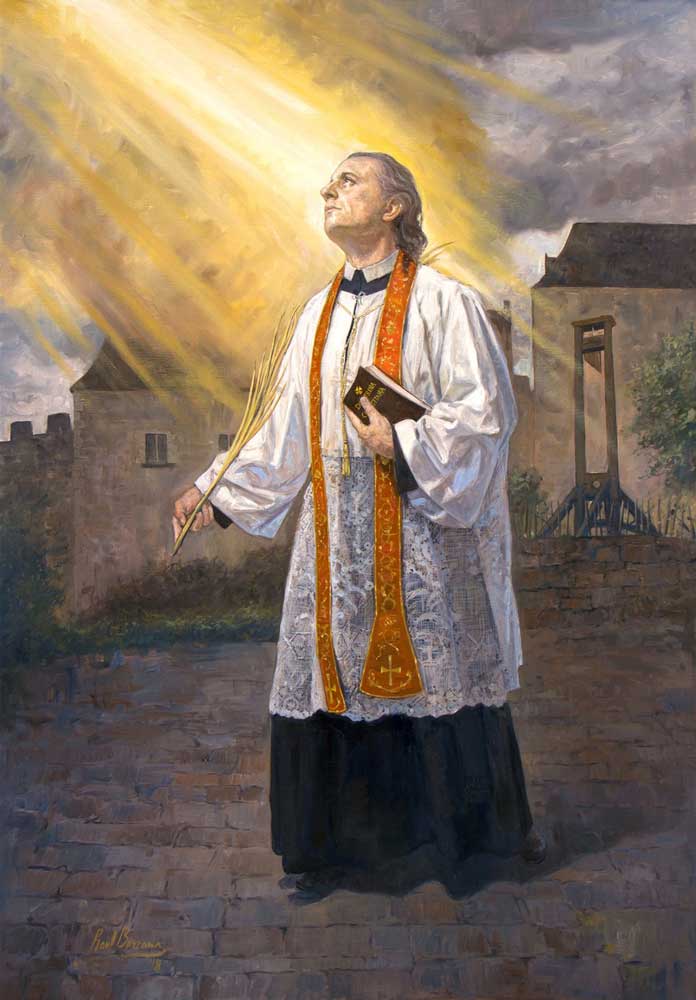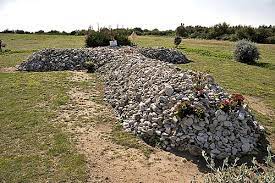Significant figures
The Blessed Doctrinarian Martyrs
Before 1789, the Fathers of Christian Doctrine had 64 houses, colleges or seminaries in France, 29 of which were in the province of Avignon alone. The French Revolution marked the end of the presence of the Doctrinaires in France. After several attempts, it was necessary to wait until 1966 to see their stable presence again. Two Fathers, Claude Bouchot and Eustace Felix, martyrs of September 1792, were beatified by Pope Pius XI in 1926. To their name must be added that of Father Joseph Raoulx, born in Graveson and General Assistant of the Congregation, guillotined in Paris in 1794, whose beatification process is underway. Worthy disciples of Father Cesare, the three doctrinaries, belonging to the same community of Paris, offered their lives in fidelity to Jesus Christ, to the Church and to the Congregation, becoming “living catechisms”.
The Blessed Claudio Bochot and Eustachio Felix
 In 1676 the General House of the Congregation was transferred from Saint-Jean-le-Vieux in Avignon to Saint-Charles Borromeo in Paris. From that date until the French Revolution, this latter House was the center of the Congregation. When the Revolution broke out, the Superior, Father Claudio Bochot, and the bursar, Father Eustachio Felix, managed to save most of the brothers. When the revolutionaries arrived, all those who did not subscribe to the “Civil Constitution of the Clergy” were arrested, deported and killed. This happened to the two fathers who were taken to the Seminary of San Firmino, which in the meantime had been transformed into a prison. The Abbot of Salamon, an eyewitness who miraculously escaped the massacre that occurred on the night of September 1st to 2nd, recounts: “The other prisoners who were already at the Abbey were informed that they had been massacred at the Convent of Carmine. At this news, everyone threw themselves at the feet of the Curé of Saint Jean au Gréve, asking him with great compunction for absolution in articulo mortis. That holy man, after having prayed for a moment in silence, exhorted us to recite the Confiteor and to make an act of faith, contrition and love of God; after which he gave absolution very devoutly. The Curé said to us: “We can consider ourselves as sick people in agony, but while we retain our reason and full knowledge, we must not omit anything that can merit God’s mercy. I will recite the prayers of the dying; join me, so that God may have mercy on us.” He began the Litany, to which we all responded with fervor. The tone in which that worthy Priest pronounced the first prayer, which begins: “Depart, soul, from this world in the name of God the Father Almighty…” moved us; almost all of us wept. Everything was prepared for the horrible massacre; we were approaching the fatal hour. They brought us dinner; it was two o’clock; we heard the roar of the alarm cannon… One of us, restless, agitated, went to a window; he saw soldiers in the courtyard of the palace and asked why the alarm cannon had thundered. “Verdun was taken by the Prussians,” was the reply. This was a lie; Verdun did not fall until a few days later. Everyone knows now that the roar of the alarm cannon was to be the signal for the massacre on that bloody day. The assassins had orders to begin the killing at the third shot.” The decree for their beatification says that they were killed inside the House, or thrown out of the window onto the street, where there were ferocious women who rushed upon the priests to beat them bloody with sticks; not content with this, they climbed onto the carts where the bodies were placed and trampled them, cut them into pieces and proudly showed the limbs to passers-by shouting “Long live the Nation”. Very little is known about the lives of these two doctrinaires. Father Claude Bochot was born in Troyer, in Champagne, on July 13, 1720, the son of Eustace and Elizabeth Léger. He entered the Novitiate of the same House of Saint Charles on October 10, 1740 and made his profession on October 16, 1741. In 1759 he was Rector of the College of Noyer and then moved to the House of Saint Charles, where he was elected Rector several times, the last time from 1789 to 1792. Father Eustace was also born in Troyer, on April 24, 1736. He entered the Novitiate of the Congregation in Paris on May 20, 1757. After having been in various communities, Vitry-le–François, Chaumont–en–Bassigny, he returned to the House of Saint Charles, with the office of Procurator, which he retained until his imprisonment in 1785. He participated in the Provincial Chapters of 1786 and 1789. During the latter he was elected Councilor of the Province. As such, on October 11, 1791, he signed the last resolution taken by the Doctrinaries of Paris. Both fathers are remembered for their exemplary lives spent entirely in the exercise of the sacred ministry for the benefit of their brothers. Humility and charity stood out in them: two qualities that form apostles and enable them to provide spiritual and material help wherever need requires it. The places where these massacres took place soon became a destination for pilgrimages, where many people went to pray in honor of the sacrificed priests. Fathers Claudio and Eustace were beatified, along with 189 other martyrs of the French Revolution, on October 17, 1926. The liturgical feast was established on September 2.
In 1676 the General House of the Congregation was transferred from Saint-Jean-le-Vieux in Avignon to Saint-Charles Borromeo in Paris. From that date until the French Revolution, this latter House was the center of the Congregation. When the Revolution broke out, the Superior, Father Claudio Bochot, and the bursar, Father Eustachio Felix, managed to save most of the brothers. When the revolutionaries arrived, all those who did not subscribe to the “Civil Constitution of the Clergy” were arrested, deported and killed. This happened to the two fathers who were taken to the Seminary of San Firmino, which in the meantime had been transformed into a prison. The Abbot of Salamon, an eyewitness who miraculously escaped the massacre that occurred on the night of September 1st to 2nd, recounts: “The other prisoners who were already at the Abbey were informed that they had been massacred at the Convent of Carmine. At this news, everyone threw themselves at the feet of the Curé of Saint Jean au Gréve, asking him with great compunction for absolution in articulo mortis. That holy man, after having prayed for a moment in silence, exhorted us to recite the Confiteor and to make an act of faith, contrition and love of God; after which he gave absolution very devoutly. The Curé said to us: “We can consider ourselves as sick people in agony, but while we retain our reason and full knowledge, we must not omit anything that can merit God’s mercy. I will recite the prayers of the dying; join me, so that God may have mercy on us.” He began the Litany, to which we all responded with fervor. The tone in which that worthy Priest pronounced the first prayer, which begins: “Depart, soul, from this world in the name of God the Father Almighty…” moved us; almost all of us wept. Everything was prepared for the horrible massacre; we were approaching the fatal hour. They brought us dinner; it was two o’clock; we heard the roar of the alarm cannon… One of us, restless, agitated, went to a window; he saw soldiers in the courtyard of the palace and asked why the alarm cannon had thundered. “Verdun was taken by the Prussians,” was the reply. This was a lie; Verdun did not fall until a few days later. Everyone knows now that the roar of the alarm cannon was to be the signal for the massacre on that bloody day. The assassins had orders to begin the killing at the third shot.” The decree for their beatification says that they were killed inside the House, or thrown out of the window onto the street, where there were ferocious women who rushed upon the priests to beat them bloody with sticks; not content with this, they climbed onto the carts where the bodies were placed and trampled them, cut them into pieces and proudly showed the limbs to passers-by shouting “Long live the Nation”. Very little is known about the lives of these two doctrinaires. Father Claude Bochot was born in Troyer, in Champagne, on July 13, 1720, the son of Eustace and Elizabeth Léger. He entered the Novitiate of the same House of Saint Charles on October 10, 1740 and made his profession on October 16, 1741. In 1759 he was Rector of the College of Noyer and then moved to the House of Saint Charles, where he was elected Rector several times, the last time from 1789 to 1792. Father Eustace was also born in Troyer, on April 24, 1736. He entered the Novitiate of the Congregation in Paris on May 20, 1757. After having been in various communities, Vitry-le–François, Chaumont–en–Bassigny, he returned to the House of Saint Charles, with the office of Procurator, which he retained until his imprisonment in 1785. He participated in the Provincial Chapters of 1786 and 1789. During the latter he was elected Councilor of the Province. As such, on October 11, 1791, he signed the last resolution taken by the Doctrinaries of Paris. Both fathers are remembered for their exemplary lives spent entirely in the exercise of the sacred ministry for the benefit of their brothers. Humility and charity stood out in them: two qualities that form apostles and enable them to provide spiritual and material help wherever need requires it. The places where these massacres took place soon became a destination for pilgrimages, where many people went to pray in honor of the sacrificed priests. Fathers Claudio and Eustace were beatified, along with 189 other martyrs of the French Revolution, on October 17, 1926. The liturgical feast was established on September 2.
The Servant of God Giuseppe Raoulx and Father Sebastiano Dubarry
 Quando nel 1789 divampò la Rivoluzione Francese padre Raoulx si rifiutò di firmare il giuramento per la “Costituzione Civile del Clero” e si nascose per paura di essere anche lui ucciso nella strage del settembre 1792. Cambiò nome, si dedicò al commercio ed evitò di esercitare il ministero alla luce del giorno. Nonostante ciò cadde in una trappola preparata dal suo accusatore e fu riconosciuto: costui rivolse al Servo di Dio una domanda in termini di bestemmie contro la Religione e Cristo Redentore, padre Giuseppe replicò animatamente e dimostrò di essere prete. Fu rinchiuso nel carcere di San Lazzaro con l’accusa di aver rifiutato il giuramento e di esser stato trovato in possesso di un libro “La devozione messa d’accordo con il giuramento di uguaglianza” che prendeva in giro i preti che prestarono giuramento. Nel carcere condusse la vita di una comunità religiosa con le ore riservate alla preghiera, letture e altri esercizi di pietà, si rivolgeva ai suoi compagni parlando della necessità di prepararsi alla morte. Quando fu convocato davanti al tribunale ringraziò il Cielo perché gli era concesso di morire per il suo Dio. Condannato a morte il 25 luglio 1794 fu ghigliottinato lo stesso giorno. Chiese di essere trucidato per ultimo al fine di poter dare l’assoluzione ai compagni, così nelle ultime ore della sua vita, poté riprendere le sue funzioni sacerdotali esortando e incoraggiando i condannati. Nello stesso gruppo fu ghigliottinato anche il famoso poeta Andrea Chenier, 32 anni. Padre Raoulx era nato a Graveson, tra Avignon e Tarascon, il 17 agosto 1737. Era entrato nella Congregazione dei Padri della Dottrina Cristiana a sedici anni e nel 1789 era Assistente Generale per la Provincia d’Avignone e godeva fama di insigne predicatore. His process of beatification, along with a large group of other religious, was completed in Paris. Now, at the Congregation for the Causes of Saints, the beatification is awaited. His process of beatification, along with a large group of other religious, was completed in Paris. Now, at the Congregation for the Causes of Saints, the beatification is awaited.
Quando nel 1789 divampò la Rivoluzione Francese padre Raoulx si rifiutò di firmare il giuramento per la “Costituzione Civile del Clero” e si nascose per paura di essere anche lui ucciso nella strage del settembre 1792. Cambiò nome, si dedicò al commercio ed evitò di esercitare il ministero alla luce del giorno. Nonostante ciò cadde in una trappola preparata dal suo accusatore e fu riconosciuto: costui rivolse al Servo di Dio una domanda in termini di bestemmie contro la Religione e Cristo Redentore, padre Giuseppe replicò animatamente e dimostrò di essere prete. Fu rinchiuso nel carcere di San Lazzaro con l’accusa di aver rifiutato il giuramento e di esser stato trovato in possesso di un libro “La devozione messa d’accordo con il giuramento di uguaglianza” che prendeva in giro i preti che prestarono giuramento. Nel carcere condusse la vita di una comunità religiosa con le ore riservate alla preghiera, letture e altri esercizi di pietà, si rivolgeva ai suoi compagni parlando della necessità di prepararsi alla morte. Quando fu convocato davanti al tribunale ringraziò il Cielo perché gli era concesso di morire per il suo Dio. Condannato a morte il 25 luglio 1794 fu ghigliottinato lo stesso giorno. Chiese di essere trucidato per ultimo al fine di poter dare l’assoluzione ai compagni, così nelle ultime ore della sua vita, poté riprendere le sue funzioni sacerdotali esortando e incoraggiando i condannati. Nello stesso gruppo fu ghigliottinato anche il famoso poeta Andrea Chenier, 32 anni. Padre Raoulx era nato a Graveson, tra Avignon e Tarascon, il 17 agosto 1737. Era entrato nella Congregazione dei Padri della Dottrina Cristiana a sedici anni e nel 1789 era Assistente Generale per la Provincia d’Avignone e godeva fama di insigne predicatore. His process of beatification, along with a large group of other religious, was completed in Paris. Now, at the Congregation for the Causes of Saints, the beatification is awaited. His process of beatification, along with a large group of other religious, was completed in Paris. Now, at the Congregation for the Causes of Saints, the beatification is awaited.  In 1794, over 800 priests and religious were embarked on two old ships that remained anchored at the mouth of the Charente River, opposite the island of Aix. Among them was the doctrinaire Father Sebastian Dubarry, condemned to maritime deportation. They lived a hell of suffering and after five months of unbearable detention, 547 deaths were counted.
In 1794, over 800 priests and religious were embarked on two old ships that remained anchored at the mouth of the Charente River, opposite the island of Aix. Among them was the doctrinaire Father Sebastian Dubarry, condemned to maritime deportation. They lived a hell of suffering and after five months of unbearable detention, 547 deaths were counted.
On the beach of the Isle Madame, in the estuary of the Charente River, pilgrims placed a cross of pebbles, on the site where many martyrs were buried, symbolically indicating their tomb.
Father Sebastian Dubarry died on August 25, 1794, at the age of 31: he is awaiting beatification.
